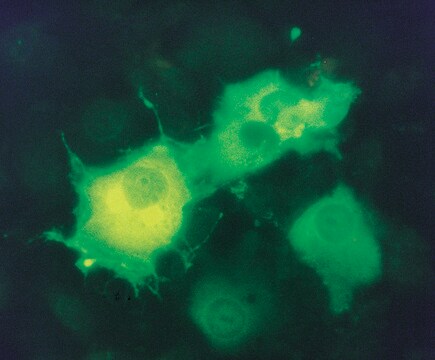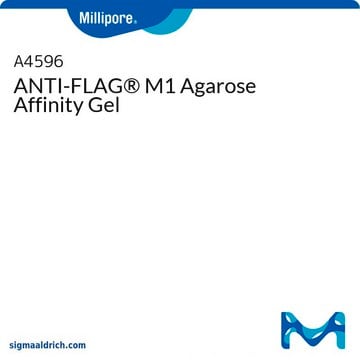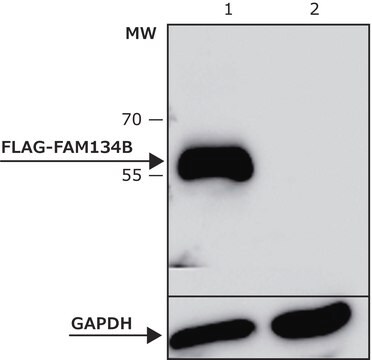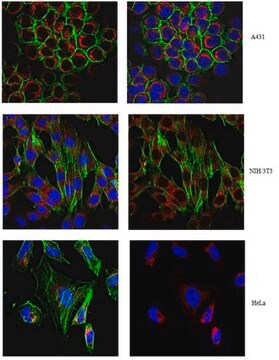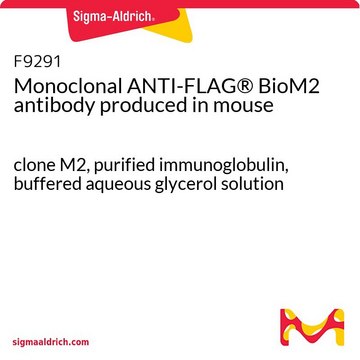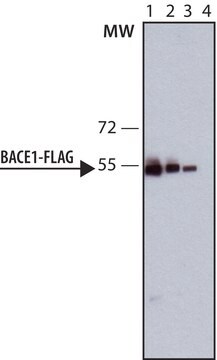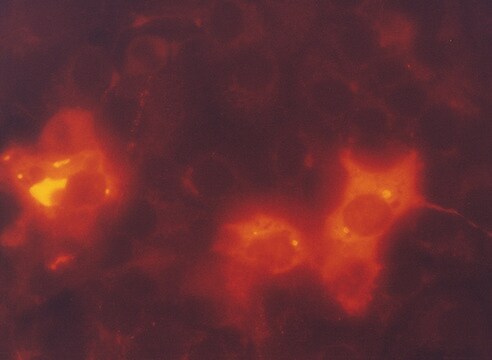MAB3118
Anti-DYKDDDDK (FLAG® epitope tag) Antibody, clone 2EL-1B11
ascites fluid, clone 2EL-1B11, Chemicon®
Sinônimo(s):
Anti-FLAG Antibody, FLAG Tag Antibody
About This Item
Produtos recomendados
fonte biológica
mouse
Nível de qualidade
forma do anticorpo
ascites fluid
tipo de produto de anticorpo
primary antibodies
clone
2EL-1B11, monoclonal
reatividade de espécies
vertebrates, E. coli
reatividade da espécie (prevista por homologia)
rat
fabricante/nome comercial
Chemicon®
técnica(s)
ELISA: suitable
immunocytochemistry: suitable
immunofluorescence: suitable
immunoprecipitation (IP): suitable
western blot: suitable
Isotipo
IgG1
Condições de expedição
dry ice
modificação pós-traducional do alvo
unmodified
Descrição geral
FLAG® is a registered trademark of Sigma-Aldrich Biotechnology LP and Sigma-Aldrich Co.
Especificidade
Imunogênio
Aplicação
A 1:1,000-1:5,000 dilution of a previous lot was used in IF.
Immunoprecipitation:
A 1:1,000-1:5,000 dilution of a previous lot was used IP on recombinant proteins.
ELISA:
A 1:1,000-1:5,000 dilution of a previous lot was used in Enzyme-linked immunosorbent assay on recombinant proteins.
Note: Does not require Ca++ for binding.
Immunoblotting:
on recombinant proteins
Optimal working dilutions must be determined by the end user.
Epitope Tags & General Use
Epitope Tags
Qualidade
Western Blot Analysis:
1:500 dilution of this lot detected Flag mTor on Flag-mTOR blot.
Ligação
forma física
Armazenamento e estabilidade
Handling Recommendations: Upon receipt, and prior to removing the cap, centrifuge the vial and gently mix the solution. Aliquot into microcentrifuge tubes and store at -20°C. Avoid repeated freeze/thaw cycles, which may damage IgG and affect product performance.
Nota de análise
Cells transfected with FLAG-tagged fusion vector
Outras notas
Informações legais
Exoneração de responsabilidade
Não está encontrando o produto certo?
Experimente o nosso Ferramenta de seleção de produtos.
Código de classe de armazenamento
10 - Combustible liquids
Classe de risco de água (WGK)
WGK 1
Ponto de fulgor (°F)
Not applicable
Ponto de fulgor (°C)
Not applicable
Certificados de análise (COA)
Busque Certificados de análise (COA) digitando o Número do Lote do produto. Os números de lote e remessa podem ser encontrados no rótulo de um produto após a palavra “Lot” ou “Batch”.
Já possui este produto?
Encontre a documentação dos produtos que você adquiriu recentemente na biblioteca de documentos.
Os clientes também visualizaram
Nossa equipe de cientistas tem experiência em todas as áreas de pesquisa, incluindo Life Sciences, ciência de materiais, síntese química, cromatografia, química analítica e muitas outras.
Entre em contato com a assistência técnica


